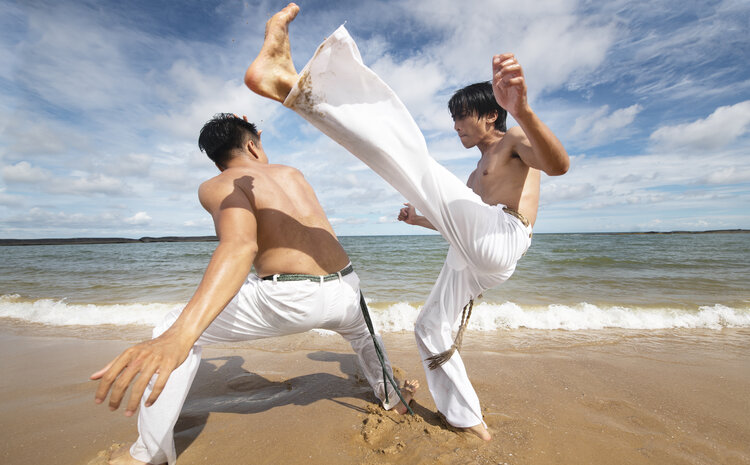Immerse yourself in the vibrant world of capoeira, a thrilling blend of martial arts, dance, and music originating from Afro-Brazilian traditions. This post will delve into the heart of capoeira’s rhythmic enchantment, exploring the key role musical instruments play in this spectacular art form.
Music is an essential element of capoeira, guiding the movements of the capoeiristas, and setting the tone for the entire encounter. And at the heart of this melody lie the traditional instruments that churn out the captivating sounds. We will journey together through the history, features, and roles of these unique instruments.
Have you ever wondered what gives capoeira its soulful rhythm? The answer lies within the instruments of the Capoeira bateria or orchestra. Each instrument carries its distinct voice, contributing to the overall melody that is as complex and intriguing as the movements of the martial art itself.
Get ready to discover the bewitching allure of the berimbau, the primal beat of the atabaque drum, and the sharp call of the agogô bells. Each has its unique story, its individual charm, and an irreplaceable role in the capoeira circle.
Venture into this sonic universe of rhythm and magic, and explore how each instrument helps to weave the intricate tapestry of sound that is capoeira. It’s a symphony of cultural heritage and tradition, all synchronized to the dynamic flow of a martial art that continues to captivate and inspire globally. Let the rhythm guide you, as we embark on this musical journey together.
The Rhythm in Capoeira: The Instruments
In Capoeira, a martial art that combines elements of dance, acrobatics, and music, the instruments play a crucial role in setting the rhythm and mood of the game. The three main instruments used in Capoeira are the berimbau, the atabaque, and the pandeiro.
The Berimbau
The Berimbau is the most essential instrument in Capoeira. It is a single-string percussion instrument, a musical bow, made of wood and steel wire, traditionally from the biriba tree. The berimbau’s unique sound sets the tempo and style of the Capoeira game.
- Berra-Boi: The largest type of berimbau with the lowest tone. It sets the base rhythm.
- Medio: This is a medium-sized berimbau, with a medium tone. It can follow the rhythm of the Berra-Boi or introduce variations.
- Viola: The smallest berimbau with the highest tone. It usually plays the lead role, dictating the rhythm.
The Atabaque
The Atabaque is a tall, wooden, Afro-Brazilian hand drum. Its role in Capoeira is to keep a steady beat, following the rhythm set by the berimbaus. The tone of the atabaque can be adjusted by tightening or loosening the ropes that hold the head of the drum.
The Pandeiro
The Pandeiro is similar to a tambourine, and it adds a distinct flavor to the Capoeira music. It provides a syncopated, sizzling sound to the rhythm.
The Magic of Capoeira: The Role of Instruments
These instruments do not merely provide a beat for the capoeiristas to follow. They create an immersive atmosphere that dictates the style and energy of the game.

The Berimbau and the Game
The berimbau commands the Capoeira roda (circle). The rhythm it plays determines the type of game that should be played – fast and energetic, slow and strategic, or somewhere in between.
The Atabaque and the Pandeiro
While the berimbau directs, the atabaque and pandeiro support, providing a rhythmic and sonic backdrop against which the game is played. They enhance the music’s texture and fill the roda with pulsating energy.
The Interplay of Instruments and Movement
In Capoeira, there’s a symbiotic relationship between the music and the movement. The instruments communicate with the capoeiristas, telling them when to move and how to play.

Connection with the Berimbau
Capoeiristas must stay connected with the rhythm of the berimbau, allowing it to guide their movements. The music becomes a dialogue – the berimbau ‘speaks’, and the capoeiristas ‘answer’ with their movements.
The Atabaque and Pandeiro in Harmony
The atabaque and pandeiro follow the berimbau, but also contribute to the conversation. The rhythm they provide creates a flow, a continuity, that frames the capoeira game. Their sounds contribute to the rich, multi-layered music that is integral to Capoeira.
The magic of Capoeira lies not just in its physicality, but also in its musicality. The interplay of movement and music, driven by the instruments, creates a vibrant and dynamic art form that is both beautiful and powerful.
Conclusion
In conclusion, the role of musical instruments in Capoeira goes beyond merely providing a beat to follow. The berimbau, atabaque, and pandeiro are integral components of this unique Brazilian martial art, dictating the rhythm, style, and energy of the game. The berimbau, with its unique sound and variety of tones, takes the lead, guiding capoeiristas’ movements and setting the pace of the game. Conversely, the atabaque and pandeiro offer support, maintaining a steady rhythm, enhancing the music’s texture, and filling the roda with vibrant energy. The symbiotic relationship between music and movement in Capoeira, steered by these instruments, results in a multi-layered, dynamic art form that seamlessly combines physicality and musicality. The dialogue between the instruments and the capoeiristas creates an immersive atmosphere that is quintessential to the magic and beauty of Capoeira. Therefore, the instruments do not just contribute to Capoeira; they embody its spirit, rhythm, and magic, making them as much a part of the game as the players themselves.
